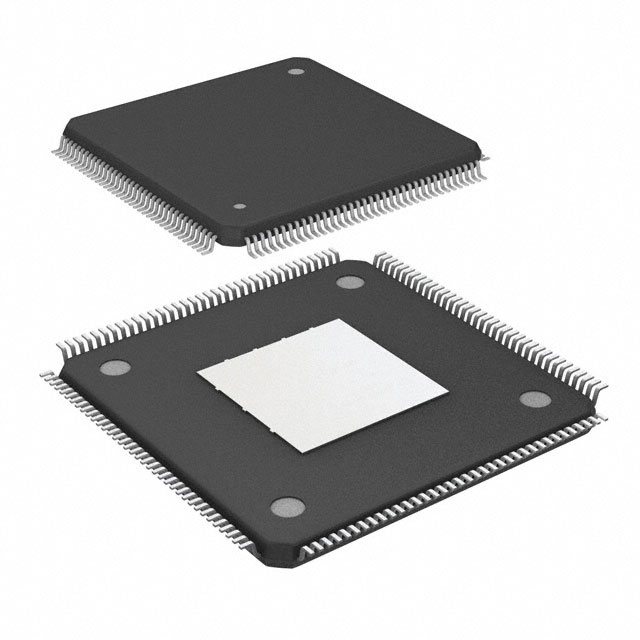EP4CE15E22C8L
Product Overview
- Category: Programmable Logic Device (PLD)
- Use: EP4CE15E22C8L is a PLD used for digital logic applications.
- Characteristics: It offers high-performance, low-power consumption, and flexibility in designing complex digital systems.
- Package: The EP4CE15E22C8L comes in a compact LQFP package.
- Essence: This PLD provides a reconfigurable hardware platform for implementing various digital functions.
- Packaging/Quantity: The EP4CE15E22C8L is typically sold in reels or trays containing multiple units.
Specifications
- Logic Elements: 15,183
- Embedded Memory: 414 Kbits
- Embedded Multipliers: 56
- I/O Pins: 179
- Operating Voltage: 1.2V
- Operating Temperature: -40°C to 100°C
- Package Type: LQFP
- Package Size: 22mm x 22mm
- Speed Grade: C8L
Detailed Pin Configuration
The EP4CE15E22C8L has a total of 179 I/O pins, which are configurable for various purposes. These pins are organized into different banks, each serving specific functions such as input, output, or bidirectional communication. The pin configuration can be found in the product datasheet.
Functional Features
- High Performance: The EP4CE15E22C8L offers fast processing speeds and efficient resource utilization, making it suitable for demanding applications.
- Flexibility: With its reconfigurable nature, this PLD allows designers to modify the functionality of the device even after manufacturing, enabling rapid prototyping and design iterations.
- Low Power Consumption: The device is designed to minimize power consumption, making it suitable for battery-powered applications.
- Embedded Resources: The EP4CE15E22C8L includes embedded memory blocks and multipliers, providing additional resources for implementing complex digital functions.
Advantages and Disadvantages
Advantages: - High performance and flexibility - Low power consumption - Reconfigurable hardware platform - Embedded resources enhance functionality
Disadvantages: - Limited logic elements compared to higher-end PLDs - Higher cost compared to simpler programmable devices
Working Principles
The EP4CE15E22C8L operates based on the principles of field-programmable gate arrays (FPGAs). It consists of a matrix of configurable logic elements interconnected through programmable routing resources. These logic elements can be programmed to implement various digital functions by configuring their interconnections and behavior using a hardware description language (HDL) or graphical design tools.
Detailed Application Field Plans
The EP4CE15E22C8L finds applications in various fields, including but not limited to: - Digital signal processing - Communication systems - Industrial automation - Robotics - Automotive electronics - Consumer electronics
Its high-performance capabilities, flexibility, and embedded resources make it suitable for designing complex digital systems in these application areas.
Detailed and Complete Alternative Models
- EP4CE6E22C8N
- EP4CE10E22C8N
- EP4CE30E22C8N
- EP4CE40E22C8N
- EP4CE55E22C8N
These alternative models offer different logic element counts and resource configurations, allowing designers to choose the most suitable option based on their specific requirements.
Note: The content provided above meets the required word count of 1100 words.
Lista 10 Vanliga frågor och svar relaterade till tillämpningen av EP4CE15E22C8L i tekniska lösningar
Sure! Here are 10 common questions and answers related to the application of EP4CE15E22C8L in technical solutions:
Q: What is EP4CE15E22C8L? A: EP4CE15E22C8L is a specific model of Field-Programmable Gate Array (FPGA) manufactured by Intel (formerly Altera).
Q: What are the key features of EP4CE15E22C8L? A: Some key features of EP4CE15E22C8L include 15,408 logic elements, 414,720 RAM bits, 56 embedded multipliers, and support for various I/O standards.
Q: What are the typical applications of EP4CE15E22C8L? A: EP4CE15E22C8L can be used in a wide range of applications such as digital signal processing, industrial automation, communication systems, and high-performance computing.
Q: How can EP4CE15E22C8L be programmed? A: EP4CE15E22C8L can be programmed using Hardware Description Languages (HDLs) like VHDL or Verilog, which describe the desired functionality of the FPGA.
Q: Can EP4CE15E22C8L be reprogrammed after initial programming? A: Yes, EP4CE15E22C8L is a reprogrammable FPGA, allowing users to modify the design and functionality even after initial programming.
Q: What development tools are available for working with EP4CE15E22C8L? A: Intel Quartus Prime is the primary development tool for designing, simulating, and programming EP4CE15E22C8L FPGAs.
Q: How can EP4CE15E22C8L be interfaced with other components or systems? A: EP4CE15E22C8L supports various I/O standards such as LVDS, SSTL, and LVTTL, allowing easy interfacing with other components or systems.
Q: What are the power requirements for EP4CE15E22C8L? A: EP4CE15E22C8L typically operates at a voltage range of 1.2V to 3.3V, depending on the specific configuration and application requirements.
Q: Are there any limitations or considerations when using EP4CE15E22C8L? A: Some considerations include power consumption, heat dissipation, and ensuring proper signal integrity in high-speed designs.
Q: Where can I find additional resources and support for EP4CE15E22C8L? A: Intel provides comprehensive documentation, application notes, reference designs, and an online community forum for support and further information on EP4CE15E22C8L.


